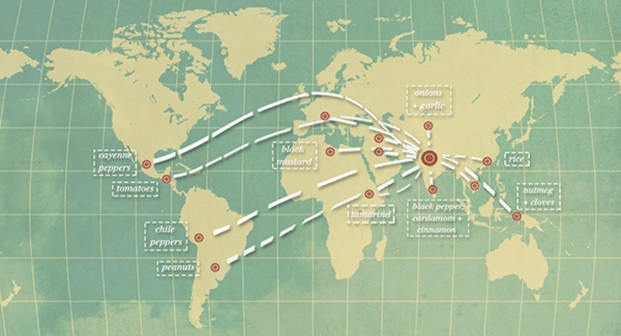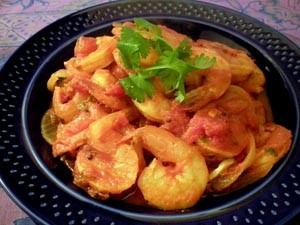The booksigning at the Smithsonian went well. Actually it went very well – we old and signed all but two of the books purchased for the event. I also really enjoyed meeting people and discussing the book with them. I was pleased to see that people were most interested in the book’s message that cuisines are interconnected, and how dishes we think of as cornerstones of national cuisines actually contain ingredients from all over the world.
To that end, I thought that a demonstration of how globally-sourced ingredients were combined for one of my favorite subcontinental dishes was in order. The recipe is for a delicious sweet, spicy, hot and sour shellfish that will amaze you. The recipe and description are followed by an analysis of ingredients and their origins. What seems like and Indian or subcontinental dish has connections to four continents and many nations. It is truly global, and should be savored by all.
Shrimp or Scallops in a Spicy Tomato Sauce
Ingredients
1 pound shrimp, peeled, rinsed and deveined, or
1 pound sea or bay scallops
¼ teaspoon cayenne pepper
¼ teaspoon ground turmeric
1 tablespoon mustard or other seed oil
2 tablespoons peanut or light sesame oil
2-3 teaspoons fennel seeds
1 teaspoon yellow mustard seeds
4-5 hot, dried, red chili peppers, torn or chopped
1 large onion peeled, sliced, and separated into crescents
3-4 teaspoons garlic, peeled and chopped
¼ cup of water to moisten (more if needed)
3 teaspoons ground cumin
1 ½ teaspoons ground coriander
1 ½ cups tomato sauce
1 teaspoon tamarind paste dissolved into 2–3 tablespoons lemon juice
1 teaspoon salt
½ cup plain yogurt
1 medium bunch fresh cilantro leaves, chopped (20–30 sprigs)
¼ teaspoon Indian Garam Masala
Directions
Shuck and devein shrimp or prepare scallops and place into a bowl with the cayenne pepper, turmeric, and a pinch of salt. Stir well, cover, and set aside for at least 1 hour.
Heat oil in a sauté pan over medium heat and when hot, sauté the fennel seeds for a minute or two. Remove from heat and let sit while shrimp or scallops marinate in the spices.
When almost ready to cook, reheat oil and add the mustard seeds and chili peppers and sauté for a minute. The mustard seeds may pop as the warm up, so you may wish to cover the pan, and shake to move contents. When done, remove from heat and let sit for five minutes.
Warm the sauté pan with the fennel and mustard seeds up again and add the onions and garlic. Stir and fry until the onions turn translucent and start to turn golden.
Add water to moisten. When water is warm, put in the cumin, coriander, and tomato and mix well. Cook 3–5 minutes to fully warm the spices.
Add tomato sauce, tamarind, lemon juice mixture, and salt. Cook to warm and add yogurt and cilantro leaves. Cover and gently cook for 15 minutes. Add garam masala and mix well. (The recipe can be paused here to allow other dishes to finish.)
If paused, reheat curry base and add shrimp and cook for 3–5 minutes or until shrimp are fully cooked. Serve immediately with rice or bread.
______
Now, here comes the fun part. The map below depicts where the ingredients from this dish hail from. Lines terminate only in rough geographic areas, not on specific places:

The only ingredients that originate in India are black pepper, cardamom and cinnamon, and they are all in the garam masala used to finish the dish. Important certainly, but in this dish, almost an afterthought. Turmeric may also originate on the subcontinent, but no one is sure whether that is the case, or whether it arose in Southeast Asia and was adopted in antiquity by the Indians.
From South America there are chili peppers, and peanuts in the peanut oil, and from North America there is the tomato, and possibly the cayenne pepper. From North Africa (Southern Mediterranean) there is black mustard seed in the mustard oil, and from East Africa there is the lovely, sour tamarind pod. From Southern Europe there is fennel and yellow mustard seed and from Asia minor there is coriander or cilantro. Onions and garlic probably hail from Central Asia (Turkmenistan to Kyrgyzstan) because that is where most of the genetic diversity in Allium species is found, and cumin is Western Asia’s gem, which has been flavoring dishes from ancient Mesopotamia to today.
Cloves and nutmeg used to round out the garam masala of course come from Indonesia’s Moluccas, and the dish is usually served on rice which comes from China’s Pearl River valley, but it can also be enjoyed with bread, or potatoes from the New World.
All of these ingredients made their way to India through movement of people and ideas or through trade and conquest. Some ingredients arrived deep in prehistory, and some are relative newcomers which only arrived in the middle or late centuries in the last millennia. The Silk Road was an important part of the spread of these ingredients and in the forging of links between cuisines and cultures.
To some degree, we tend to think of the world’s borders and biodiversity much as we find them today, but a simple exercise like this shows us that this is not really the case at all, and it hasn’t been the case throughout much of human history. With apologies to locally-sourced aficionados, eating-locally is a relatively modern concept when compared to the global nature of most dishes.
Cultures combine ingredients differently, but most cuisines include ingredients from places beyond their national borders. Each bite connects us with the past and with the people who often travelled great distances to bring variety home. Diversity is a wonderful concept, appreciate it the next time you enjoy a delicious curry or stew or Koresh or bhaji or braise or . . . (Words and ingredient analysis by Laura Kelley; Photo of Shrimp or Scallops with Spicy Tomato Sauce by Celeste Heiter; Map of Ingredients drawn by Laura Kelley.)

